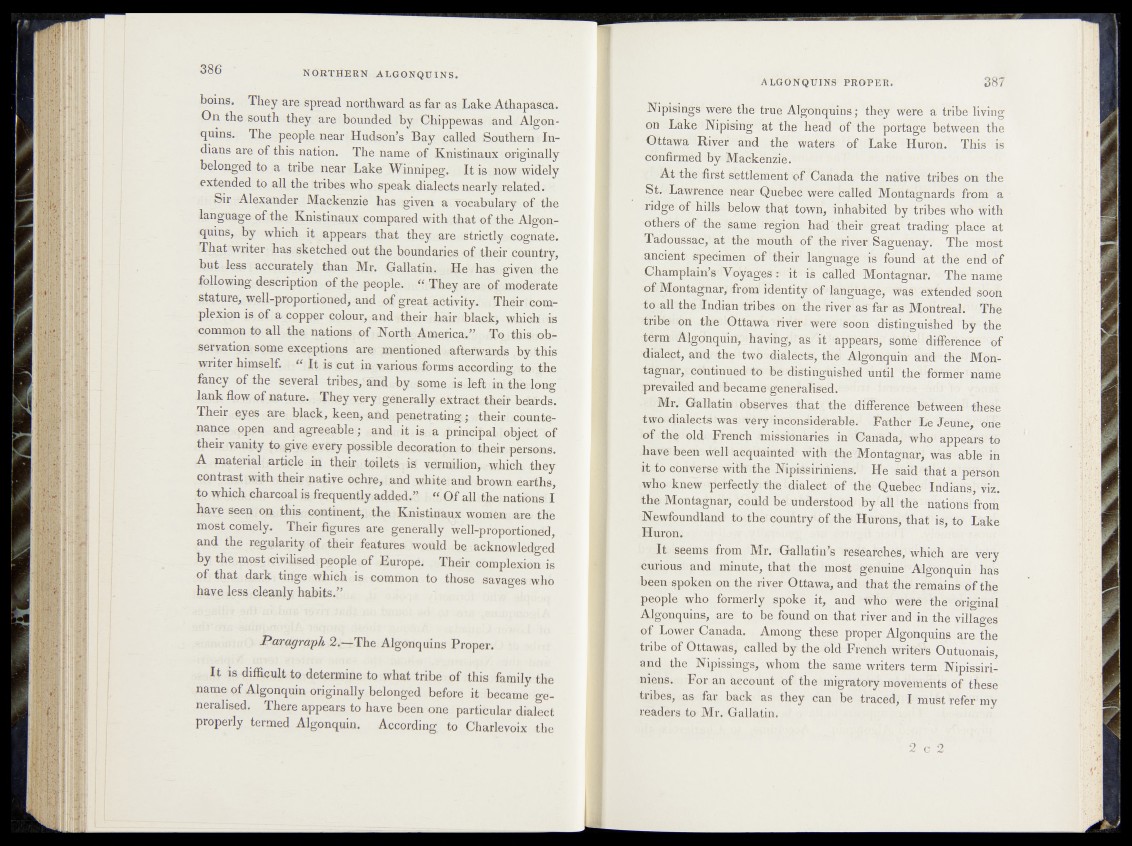
boins. They are spread northward as far as Lake. Athapasca.
On the south they , are bounded by Chippewas and Algon-
quins. The people near Hudson’s Bay called Southern Indians
are of this nation. The name of Knistinaux originally
belonged to a tribe near Lake Winnipeg. It is. now widely
extended to all the tribes who speak dialects nearly related.
Sir Alexander Mackenzie has given a vocabulary of the
language of the Knistinaux compared with that of the Algon-
quins, by which it appears. that they are strictly cognate.
That writer has sketched out the boundaries of their country,
but less accurately than Mr. Gallatin. He'has given the
following description of the people. “ They are of moderate
stature, well-proportioned, and of great, activity. < < Thgjri complexion
is of a copper colour, and their hair black, which is
eommon to all the nations ofjNorth America*gq, To ithisr.observation
some exceptions are mentioned > afterwards by this
writer himself. u It is cut in various forms according, to the
fancy of the several tribes,' and by some ;is»left in the long
lank flow of nature. They very generally extract their beards.
Their eyes are black, keen, and penetrating-• their countenance
open and agreeable; and it is a principal object of
their vanity togive every possible decoration *©! their persons.
A material article in their toilets is vermilion,,, which they
contrast with their native ochre, and white and brown earths,
to which charcoal is frequently added.’’ ! “ Of all the nations I
have seen on this continent, the Knistinaux women are the
most comely. Their figures are generally well-proportioned,
and the regularity of their features would be acknowledged
by the most civilised people of Europe. Their complexion is
of that dark tinge which is common to those savages who
have less cleanly habits.”
Paragraph 2.—The Algonquins Proper.
It is difficult to determine to wbat tribe of this family the
name of Algonquin originally belonged before it became generalised.
There appears to have been one particular dialect
properly termed Algonquin. According to Charlevoix the
ALGONQUINS PROPER. 387
Nipisings* were the true Algonquins; they were a tribe living
on Lake Nipising at the head of thé portage between the
Ottawa River and fhe waters of Lake Huron. This is
confirmed by Mackenzie.'
At the first settlement 'of Canada the native tribes on the
St; Lawrence near Quebec were called Montagnards from a
ridgie of hills below tb^t town, inhabited by tribes who with
others of the same region h a d ‘their great1 trading place at
Tadoussac,1 at the mouth óf the river Saguenay. The most
ancient specimen of their language is found at the end of
Champlain’s Voyages :< it is called Montagnar. The*name
of Montagnar, from identity of language, was extended Soon
to all the Indian tribes on the river as far as Montreal. The
tribe on the Ottawa river were*-soon distinguished by the
tirm • Algdnquin,S having,5 * as a tJ appears, some’ ’ difference of
dialect, and the two dialects, the Algonquin and the Montagnar,
continued to be distinguished until th© former name
prevailed and becamegcneralisedi
Mr. GallatinS observes that the difference* between * these
twnflialects was very inconsiderable. Father Le Jéuney orie
nf the old French missionaries in Canada, who appears to
have been vi^li ueqUainted with theMontagnar; was able in
it to eon Verse with the Mptoirifiiensdj He ihffithat a j^fson
who knew perfectly the dialect of the QuebfeHridfans] viz.
Ih© Montagnar, Could be* understood by all1 the nations1 frorii
Newfoundland to the country of the Hurons, that isy to Lake
Huron.
It seems from Mr. Gallatin’s researches, Which are very
curious and minute, that the most gerinine Algonquin • h i
been spoken on the river Ottawa, and that^he remains of the
people who formerly spoke it, and who were the original
Algonquins, are to be found on that riVer and in the villages
of Lower Canada. Among these proper Algonquins are the
tribe of Ottawasf called by the bid French writers Outuonais
and the Nipissings, whom the same writers term Nipissiri-
niens. For an aecount of the migratory movements of these
tribes, as far back as they can be traced, I mukt refer my
readers to Mr. Gallatin.